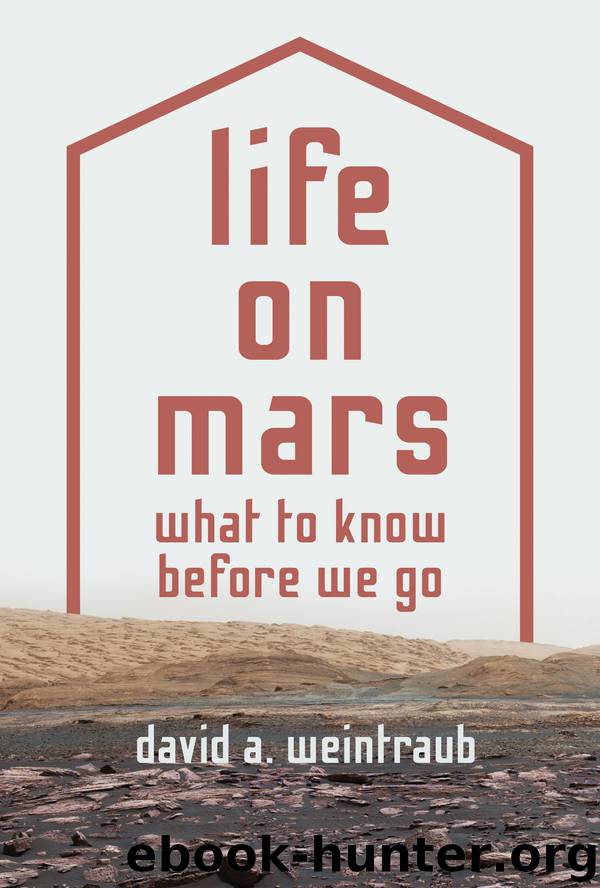Life on Mars by Weintraub David A

Author:Weintraub, David A.
Language: eng
Format: epub
ISBN: 9781400889945
Publisher: Princeton University Press
organic compounds? no or yes
The Viking landers had one more instrument whose measurements were extremely relevant to the biology experiments, even though that instrument was not formally part of the biology package. Klaus Biemann, of the Massachusetts Institute of Technology, led the team that built a miniaturized gas chromatograph with a mass spectrometer (GCMS), whose purpose was to detect and identify organic (carbon-containing) compounds near the surface of Mars. The experiment worked by heating and vaporizing a tiny soil sample. The soil was heated gradually, first to 50°C, then to 200°C, 350°C, and 500°C. A stream of hydrogen gas, which was sprayed into the GCMS, carried any vaporized gases into a chamber, where the instrument measured the light emitted by the vapors and then measured the masses of the particles in the vapor.
Biemann and his science team reported, definitively, “No organic compounds were found at either of the two landing sites.” No naphthalene (C10H8, which is the primary ingredient in mothballs), no benzene (C6H6, a manufactured derivative of coal and petroleum), no acetone (C3H6O, a naturally occurring material on Earth, formed during the metabolic breakdown of animal fat), no toluene (C7H8, first distilled from pinesap in 1837 and used as a solvent, for example in paint thinner). These experiments demonstrated that nothing in the Martian soil is effective at synthesizing organic molecules. In addition, since carbon-bearing meteoritic dust should steadily filter down through the atmosphere, the gas chromatograph/mass spectrometer experiments demonstrated that the Martian soil (or interactions of ultraviolet light and cosmic rays with the Martian soil) is effective at destroying any of those molecules that rain down onto the surface of Mars. This experiment was definitive: the absence of organic compounds in these experiments “rules out carbonaceous remnants of now extinct biological or abiological processes in the surface material of these two sites.”13
The GCMS experiment was critical to understanding and interpreting the results of the Viking biology experiments. If the GCMS experiment had been sent to Mars on a mission prior to the Viking missions, the Viking biology experiments would never have been proposed, let alone designed, built, and sent to Mars. According to Klein, Horowitz, and Biemann, writing in 1992, “The absence of organic compounds at these two very distant (from each other) sites demonstrated that there is presently neither biological nor abiological synthesis of organic compounds occurring . . . What became clear even during the Viking mission was that if the GCMS results were correct (and there was reason to believe that this was the case) the three biological experiments had essentially lost their original purpose. With no detectable trace of organic matter in the surface material, there was no possibility of finding extant life at the two landing sites.”
Furthermore, they wrote, “The Viking findings established that there is no life at the two landing sites, Chryse and Utopia. Although the two sites are 25° apart in latitude and on opposite sides of the planet, they were found to be very similar in their surface chemistry.
Download
This site does not store any files on its server. We only index and link to content provided by other sites. Please contact the content providers to delete copyright contents if any and email us, we'll remove relevant links or contents immediately.
Enlightenment Now: The Case for Reason, Science, Humanism, and Progress by Steven Pinker(7233)
A Journey Through Charms and Defence Against the Dark Arts (Harry Potter: A Journey Through…) by Pottermore Publishing(4781)
The Immortal Life of Henrietta Lacks by Rebecca Skloot(4525)
A Journey Through Divination and Astronomy by Publishing Pottermore(4344)
Elon Musk by Ashlee Vance(4028)
Origin Story: A Big History of Everything by David Christian(3648)
COSMOS by Carl Sagan(3554)
Alchemy and Alchemists by C. J. S. Thompson(3449)
Bad Pharma by Ben Goldacre(3355)
Enlightenment Now by Steven Pinker(3338)
Shadow of Night by Deborah Harkness(3302)
Inferior by Angela Saini(3276)
A Mind For Numbers: How to Excel at Math and Science (Even If You Flunked Algebra) by Barbara Oakley(3218)
Origin Story by David Christian(3147)
The Code Book by Simon Singh(3074)
Signature in the Cell: DNA and the Evidence for Intelligent Design by Stephen C. Meyer(3071)
The Elements by Theodore Gray(2998)
A Brief History of Time by Stephen Hawking(2960)
A Journey Through Potions and Herbology (A Journey Through…) by Pottermore Publishing(2828)
